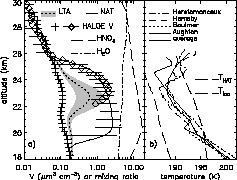 |
Figure 1. HALOE sunrise measurements on March 4, 1996. The HALOE cloud profile was at 53.8°N, 359.3°E, 6:48 UT, and the HALOE cloud-free profile was at 53.9°N, 335.2°E, 8:24 UT. The coincident MLS HNO3 observation is for March 3, 11:50 UT at 55.1°N, 7.8°E. (a) The measured cloud volume density (diamonds, error bars are ±50%) compared with volumes calculated for LTA and NAT using the average temperature profile in Figure 1b. The indicated range of calculated volumes is for varying the measured HNO3 by ±50%. Also shown are the HALOE H2O (ppmv) and MLS HNO3 (ppbv) profiles used for the volume calculations, and the HALOE cloud free profile (pluses) used to derive background H2SO4. (b) Temperatures from four radiosonde stations on March 4 at 12 UT, the average of these soundings, and TNAT and Tice computed using the H2O and HNO3 in Figure 1a. |